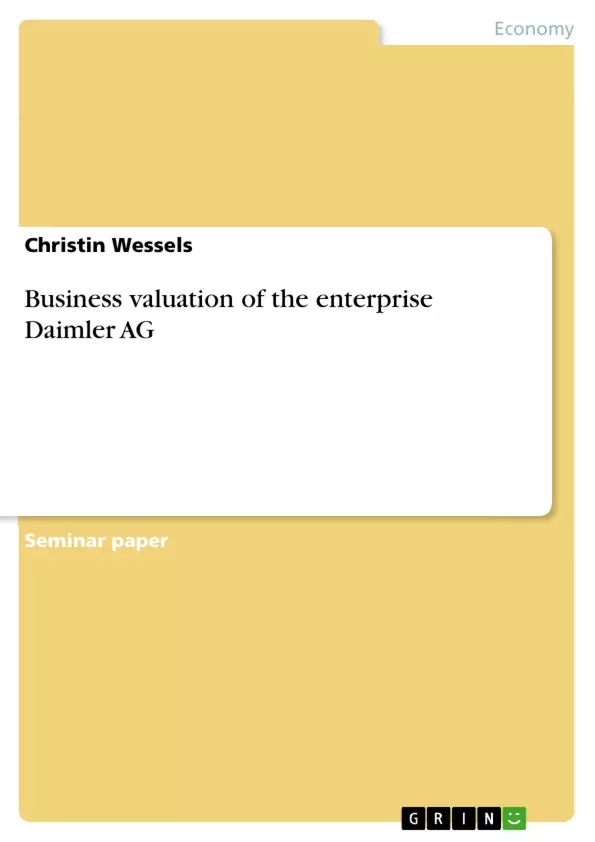The valuation of businesses is since decades a theme, which is still up to date and growing. The reason for the high interest regarding the theme is quite simple: If an enterprise is valued, there is a high amount of money involved. Business values are daily business, at the same time they have a high amount of complexity and issues, the raters are confronted with. The reason for a business value could be different, starting with management successions and ending with the buy out of an enterprise.
The value of an enterprise is subjective and contents conflicts of interests. On one hand there is the current owner. For him the enterprise has an added value because of the personal background. On the other hand, there is the further buyer of the company, who wants to pay a lower price for the company to minimize the liabilities. Because of this the value of a business depends on the target and the reason of the valuation, reflecting the motto “The Price is what you pay. Value is what you get.”
The value of the business can be calculated by different ways. In the last years, the amount of valuation methods increased. Currently there are many valuations available, which end in different results. But how is the value of an enterprise defined and calculated? Why is the value of a business needed? And what are the differences between the methods? These questions will be answered in the present assignment. The Objective is to show with the help of the concrete example Daimler AG the process of a business valuation including the calculation of the value of the enterprise.
To achieve this objective, the methodology of the present assignment is described in the following chapter first, before the theory of business valuations will be explained. The reasons for a valuation are described and the methods with a focus on Discounted cash flow methods (DCF) and multiples methods are stated. After presenting the company Daimler the methods are applied of Daimler in the fourth chapter, the business value will be calculated with the different methods. The results will be discussed in chapter five, before finally a conclusion and outlook will be given.
Inhaltsverzeichnis (Table of Contents)
- Introduction
- Problem and Objective
- Scope of Work
- Theoretical background
- Business Valuation
- Valuation methodologies
- Discounted Cash flow methods
- Entity methods
- Equity methods
- Advantages and disadvantages DCF methods
- Multiples method
- Presentation Daimler AG
- Valuation of the Company Daimler AG
- Discounted Cash flow method
- Entity method
- Equity method
- Multiples method
- Summary of the results
- Discussion
- Definition and purpose of business valuation
- Key valuation methodologies, including discounted cash flow (DCF) methods and multiples methods
- Application of these methodologies in the context of Daimler AG
- Analysis of the strengths and weaknesses of different valuation approaches
- Comparison of the resulting enterprise values derived from different methods
- Introduction: This chapter introduces the concept of business valuation, highlighting its significance and complexity. It explores the different perspectives of the current owner and a potential buyer, emphasizing the subjective nature of business value.
- Theoretical Background: This chapter delves into the theoretical underpinnings of business valuation. It discusses various valuation methodologies, focusing on discounted cash flow (DCF) methods like entity and equity approaches, and their advantages and disadvantages. It also introduces the multiples method as an alternative valuation technique.
- Valuation of the Company Daimler AG: This chapter applies the discussed valuation methods to the specific case of Daimler AG. It examines both the discounted cash flow methods (entity and equity) and the multiples method, providing detailed calculations and analysis.
Zielsetzung und Themenschwerpunkte (Objectives and Key Themes)
This assignment aims to provide a comprehensive understanding of business valuation by analyzing the case of Daimler AG. It seeks to illustrate the process of valuation, including the calculation of enterprise value, utilizing different methods.
Zusammenfassung der Kapitel (Chapter Summaries)
Schlüsselwörter (Keywords)
The key terms and concepts explored in this assignment include business valuation, discounted cash flow (DCF) methods, entity and equity approaches, multiples method, Daimler AG, enterprise value, and financial analysis.
- Citar trabajo
- Christin Wessels (Autor), 2016, Business valuation of the enterprise Daimler AG, Múnich, GRIN Verlag, https://www.grin.com/document/442181



